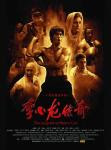
The Jeet Kune Do EmblemThe Taijitu represents the concepts of yin and yang. The Chinese characters indicate: "Using no way as way" & "Having no limitation as limitation". The arrows represent the endless interaction between yang and yin.
Also known as
JKD, Jeet Kun Do, Jun Fan Jeet Kune Do
Focus
Eclectic
Country of origin
United States
Creator
Bruce Lee
Parenthood
Various
Olympic sport
No
Official website
Bruce Lee Foundation









